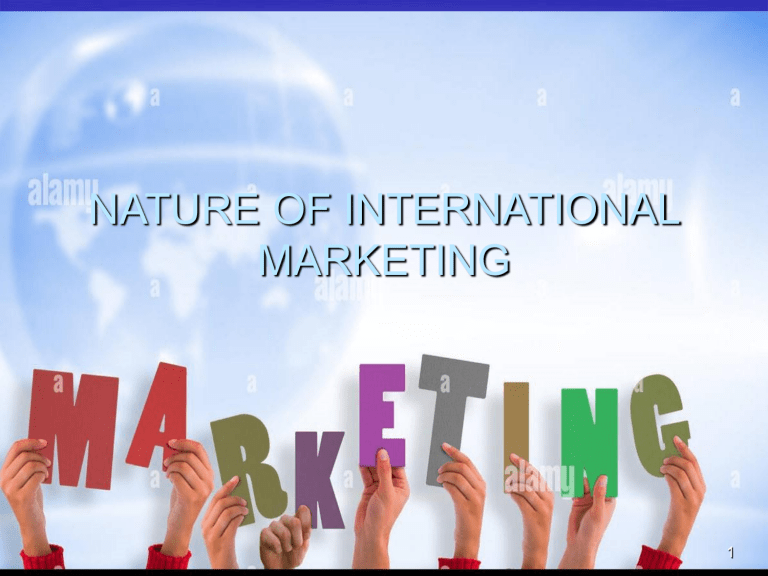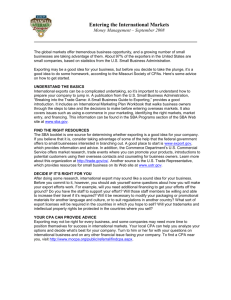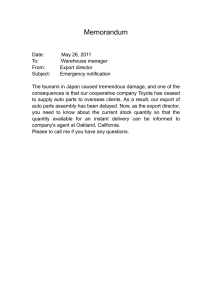
NATURE OF INTERNATIONAL MARKETING 1 What is Marketing? Marketing function charged with defining target markets and determining the BEST way to satisfy their needs and wants competitively and profitably 2 What is International Marketing? “Performance of business activities designed to plan, price, promote, and direct the flow of a company’s goods and services to consumers or users in more than one nation for a profit” 3 What is International Marketing? It is a multinational process of planning and executing the conception, pricing ,promotion, and distribution of ideas, goods, and services to create exchanges that satisfy individual and organizational objectives AMA 4 International marketing vs. Domestic marketing Foreign environment (uncontrollable) 1 Political/legal forces 7 1-5 Cultural forces Domestic environment (uncontrollable) Political/ legal forces (controllable) Price Promotion 6 Geography and Infrastructure Economic forces 2 Competitive structure Competitive Forces Product Channels of distribution 7 Level of Technology Economic climate 5 4 Structure of distribution 3 Environmental uncontrollable country market A Environmental uncontrollable country market B Environmental uncontrollable country market C 5 International trade Flow of goods and capital across national boarders No specific attention for marketing intervention 6 Exporting vs. International Marketing Exporting International Marketing Process is narrower like selling Broader managerial process Supply an order Distant end-user Up & Down demand patterns Trading-oriented only Diagnostic studies -Who is buyer? -What is the Market? -Opportunities, Channels etc. Not always a long term activity Long-term activity Market patterns, demand etc. cannot be considered short-term. Legal & other protection Legal & other protection Minimum level Higher level Strategic decisions are less involved Long term corporate patterns/strategies are considered 7 Exporting International Marketing Customer satisfaction is not considered The only marketing mix element to tailor is the Place Customer satisfaction is a major concern 4P ‘s are manipulated to tailor the offer according to the target market’s requirements. 8 The Internationalization Process Management is not interested and would not even fill an unsolicited order. Management is willing to fill solicited orders but makes no effort to explore the feasibility of active exporting. Management actively explores the feasibility of exporting. 9 The firm exports experimentally to some psychologically close country. The firm is an experience exporter to that country. Management explores the feasibility of exporting to additional countries, psychologically more distance. 10 Management orientations Ethnocentric Home country is superior See similarities in foreign countries Regiocentric See similarities and differences in a world region Polycentric Each host country is unique. See differences in foreign countries Geocentric Worldview. See similarities and differences in home and host countries 11 International Product Life Cycle 12 13 Stage 0- Local Innovation Innovations in highly developed countries 1. 2. 3. 4. Consumers are affluent Unlimited wants Technological know how Abundant capital 14 Cont… Products are first introduced to the local market. 1. Markets are familiar with local desires and market conditions 2. Risk is smaller 3. Products may require modifications after introduction 15 Stage 1 – Overseas Innovation New product is well developed Original market well cultivated Local demands adequately supplied Look to overseas markets specially other advanced nations Competition among U.S. firms. Production cost decreases- Economies of scale 16 Cont… Heavy cost for educating customers More export from U.S. More imports from other advanced nations 17 Stage 2 - Maturity Local production in other advanced nations Demand from LDC’s Innovating firm’s exports will still keep stable. 18 Stage 3 – World wide Imitation Innovating firm’s export begins to decline Low production will increase the cost. U.S. production for local consumption. Advanced nations export product through differentiation. 19 Stage 4 - Reversal LDC’s provide products to the whole world Low labor cost in LDC’s 20 stage Import/export Target market Competitors Production cost Local innovation none U.S.A Few: local firms Initially high Overseas innovation Increasing export U.S.A. and other advanced nations Few: local firms Declining due to economies of scale Maturity Stable export Advanced nations and LDCs Advanced nations Stable World wide imitation Declining export LDCs Advanced nations Increase due to lower economies of scale Reversal Increasing import U.S.A Advanced nations and LDCs Increase due to comparative disadvantage 21



